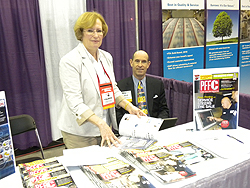FTA Gets Flexo Engines Started at Forum/Info*Flex
- Published: May 04, 2011

INDIANAPOLIS, IN | The Flexographic Technical Assn. (FTA) held its annual Forum and Info*Flex exhibition at the JW Marriott and Indiana Convention Center May 1–4. With a sold-out exhibit hall with 218 booths and standing-room-only conference sessions, attendees must be racing to meet the forum’s goal: Setting the pace for flexo packaging excellence.
Benefits of Ultra-Thin Plates
At a conference session on flexo quality, P.J. Fronczkiewicz, senior technical advisor at Flint Group, Charlotte, NC, gave a presentation that covered printing with ultra-thin (0.030 in.) plates, which consist of 0.007 in. of backing and 0.023 in. of polymer.
Although not new, these plates are not widely used. Fronczkiewicz says, “Only a handful of people are using very thin plates. I’m surprised they haven’t been scrapped altogether.” However, the plates offer ecological and user benefits that should be considered.
The biggest advantage compared to 0.067 in. plates is platemaking speed. While the thicker plate takes about 162 min to finish, the thinner plate is ready in 58 min. In terms of environmental impact, VOCs from solvents used to develop the plate are reduced by more than 50%. Global warming potential (GWP), including plate, packaging, and transport, is an estimated 32% lower, and energy consumption is 40% lower.
The thinner plate is more flexible, offering better drape and reduced cupping for more even printing and reduced dot gain. They are easier to mount and handle.
There are some disadvantages, however. The thinner plates provide less solid ink density compared to the thicker plates, and they produce a hard lead (or dark border) at the edge. A hard plate in 0.030 gauge is needed to avoid low densities, he says.
The thin plates are perfectly suited for surface screening and flat top technology to boost their performance, says Fronczkiewicz. Tape selection is important. Without surface screening, hard tape can be used to increase solid ink density and reduce hard lead edge. With surface screening, tape selection is less critical.
Making the transition to a thinner plate means changing to a larger diameter sleeve or cylinder to compensate for the difference. In either case, the transition will be gradual. Start with a common repeat for testing, and convert jobs as graphics change, he suggests.
Controlling Ink Dynamics
In a session on inks and substrates, Ed Dedman, director of emerging technology at Graymills Corp., Chicago, IL, encouraged attendees to “think like the ink” and consider what will happen to it as it flows through your process. This is the “forgotten component” in the flexo industry, he says. His presentation covered the four “C’s” to controlling total ink dynamics: condition, clean, circulate, and control.
• To condition the ink prior to printing means to control rheology. Inks should be mixed on a shaker, preferably in the inkroom, before use.
• Because the ink could be contaminated with dried bits, metal shavings, and other foreign materials, filtration is important. Clean it by using a mesh filter and a magnet to catch shavings.
• While pouring may be fine for short runs, pumping is the best way to circulate the ink. The correct pump can provide proper conditioning and reduce settling.
• Controlling the specific attributes of your ink is important to achieve correct color. Use the right tools to control the pH, temperature, and viscosity, and keep the tools clean and calibrated. Dedman says it’s critical to always adjust pH before adjusting viscosity. Because heat thins ink and can begin the curing process, a 5–10 deg C rise in temperature can increase your costs.
Dedman says much effort is given to prepress and controlling color, but the wet end of the press needs attention. Implementing the four C’s can offer a high impact for minimal cost.




